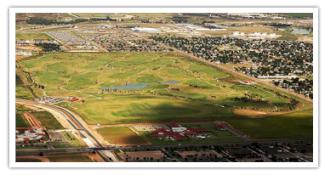Featured Golf News
Doak's Work at Rawls Course Exceeds Expectations
Editor's Note: This is the fifth in a series on the golf courses of the Big 12 Conference. In previous features, Cybergolf's Steve Habel has profiled the Traditions Club, home to the golf teams of Texas A&M University; the Jimmy Austin OU Golf Club; The University of Texas Golf Club; and Twin Rivers Golf Club, home of Baylor University's golf teams.

Aerial View of The Rawls Course
The city of Lubbock - hard at the base of the Texas Panhandle at a meeting of cotton fields, arid scrubbrush and miles of flat farmland - seems an unlikely place for one of the finest courses in golf course architect Tom Doak's burgeoning, impressive portfolio.
But here on the South Plains, on a 268-acre piece of ground surrounded by highways and so close to the Texas Tech campus you can see the university's football stadium in the very near-distance, Doak has fashioned a challenging track that is amazing and satisfying, especially considering its setting.
A minimalist by reputation, Doak and his team from Renaissance Golf stepped out of that role for this design, moving 1.3 million yards of topsoil to sculpt a course described by the architect as "probably the most complicated we've done to date."

No. 4 at The Rawls Course
Creating an entire landscape from scratch, they shaped the earth to mimic the land east and south of Lubbock, where the great plains suddenly start falling into the valleys and canyons that lead to the Caprock region.
The result is a 7,349-yard, par-72 track and a feat of engineering that fully exemplifies Doak's philosophies on design and strategy, most notably the unusually wide fairways and boldly contoured greens - all done on a former cotton field that previously had a mere 18 inches of elevation change.
The course makes you reconsider golf in the Lone Star State. Doak routed contoured fairways around craggy bunkers draped in brown sand, heaped piles of soil here and there to create the illusion of dunes, and molded aggressively tilted bentgrass greens with something akin to Augusta on his mind.
The final effect is an oasis at the edge of campus, secluded from the surrounding developed areas. While the original topography made no suggestions for what kind of golf holes Renaissance Golf would create, the strong prevailing winds had a lot to do with the final design. The varying zephyrs mean that the length of tee shots vary from day to day to ensure the course plays differently from one moment to the next.
Fairway bunkers jut prominently into the line of play, forcing players to judge whether they can make the carry in the wind conditions at the time. Wide routes provide the chance to drive to one side and use a quartering wind to help stop a shot instead of side-swiping it away. Downwind approaches will likely run quite far, so players must place tee shots around hazards in the front of the greens instead of having to carry them.
Built for Texas Tech University, the Rawls Course rests at an elevation of 3,200 feet. The track now sports up to 30 feet of up-and-down terrain, as a series of berms - some as wide as 15 feet - surround the entire venue. The grasses are irrigated by one of the most sophisticated systems ever devised; 2,500 sprinkler heads deliver up to 4,500 gallons of water a minute as determined by a computer.
Rawls Course Can be a Brute but It's Fair
The Rawls's fairways cater to big boomers off the tee, and the exceptional Tif-sport Bermuda turf allows the ball to roll considerable distances. Broad-shouldered fairways and big greens provide many options for novices, but low-handicappers who want to reach the green in regulation may have a tough go as approach shots can be problematic.
Most greens are fortified with small, finger-like bunkers that are very deep and feature fringes mowed to fairway height, so approaches coming in hot won't hold the green. Although the fairways leave plenty of room for error, only a portion of each hole provides the right angle for a shot at the flag, and on many holes the best option is a bump-and-run.
Short-game and putting strategies comprise half of Doak's concept for the Rawls Course. Many golfers will probably be need a third shot to the green on most of the long, par-4s, and with that strategy, Doak planned for interesting shots around the green. Relatively small bunkers guard oversized, multi-tiered greens which dramatically rise and fall. Finesse is the order of the day around these demanding targets.
There are 96 sand bunkers in all at the Rawls, and these deep, nasty hazards are very much in play. The fairway trap on No. 8 is the deepest, some 21 feet below the surface, making it quite likely the most cavernous in all of Texas. The huge fairway bunker on No. 7 will also test your nerves and prowess off the tee.
Beyond the short rough, an array of deep, green mounds are fitted with Bermuda and other native grasses, providing a sharp contrast to the light-colored greens. At a distance, the large berms feature wispy, blue Gramma turf, whose wheat-like appearance compliments the pines and other ornamentals along the layout. In the low-lying runoffs, Pensacola bahia - a tall, tropical grass - awaits stray shots, and at the heart of the Rawls Course is a 4.5-acre manmade lake that is integral to the course's drainage and irrigation system.
When considering a design in West Texas, wind must be factored in. Present most of the time, it comes from a fairly predictable direction, but the winds can change in a hurry. For golf, using the wind to your advantage is the key to success here. Because there may be a significant difference in wind speed from ground level to 20 feet higher, club selection is not a science on the Rawls Course. In fact, you might consider ignoring the yardage book. Choosing the right club and gauging wind patterns are based on feel and intuitiveness.
The Rawls Course (with a rating of 75.3 and a slope of 139 from the tips) is challenging - there is no doubt about that. It's long, rolling, and then there's the wind and sand. Still, Doak and team crafted a course for both the average player and expert. The idea for this collegiate layout was to build a test that would be easy to finish, but hard to ace. Choosing the correct tees is critical.
"We were given the task of creating a golf course that would test the best collegiate players in the country, and at the same time provide an enjoyable social venue for the entire university community," Doak said. "We're pretty sure it's tough enough to pass the first test, and we hope you enjoy the setting no matter your final tally."

The Closing Hole at The Rawls Course
Final Stretch is Memorable
The Rawls Course opens with a gentle balance of a short par-4 (368 yards) and a reachable par-5 (521 yards); both play with the wind. The course then turns the other direction with the devious 177-yard par-3 third (with the first real look at those huge, deep bunkers guarding an elevated green); swings back to the north at the 460-yard fifth; climbs a rise at the 355-yard seventh; and completes the front nine with a pair of arresting and tremendously bunkered long holes: a par-4 of 479 yards to perhaps one of the finest green complexes in the Southwest, and a par-5 to a tiny green that threatens missed shots right and left with scary sand traps.
The incoming nine opens with a par-3 that's with the wind and measures 220 yards. The green at the par-4 12th lurks behind and between a couple of knolls, hidden from view 80 yards out or more. The par-4 14th, at 506 yards, is simply the most intimidating two-shot hole you may ever play. It winds uphill around a passel of bunkers into the wind and up to a narrow sliver of a green under a berm that was shaped to hide a neighborhood and buffet the winds that scrape Lubbock.
The final four holes at the Rawls Course read like a U.S. Open scorecard: a par-4, followed by a par-3 and wrapping up with a pair of par-5s; with yardages of 468, 239, 630 and 578, respectively.
The drive on the final hole heads toward a plateau, the second over a canal (or, if you are really long and bold, over a lake), and the third to a green snuggled against the water's edge.
Serving as the home course for both Texas Tech golf teams, the Rawls Course earned mention as Golf magazine's No. 23 "Best Golf Courses in the U.S." for $50 or less, Golfweek's No. 3 "University Golf Course in America," and Golf Digest's second-ranked "Affordable New Public Golf Course in the U.S."
The Rawls Course is what public golf should be. It's walkable, visually and strategically interesting, picturesque, sensible, energetic and mystifying. Think Bandon Dunes on the plains of Texas, and thank Doak after you get a chance to play his creation.
For more information or a tee time, visit www.therawlscourse.com.
Steve Habel is one of Cybergolf's national correspondents, contributing news stories, features, equipment and book reviews and personality profiles from his base in Central Texas. He is also the managing editor for Texas CEO Magazine and works as a contributing editor for Horns Illustrated magazine, a publication focusing on University of Texas sports. He also writes a blog (www.shotoverthegreen.blogspot.com), which features news on golf and the Longhorns, and another (www.checkinginandplayingthrough.blogspot.com) on his many travels, which took him across the nation and to 105 different golf course in 2009. Habel is a member of the Golf Writers Association of America and the Texas Golf Writers Association.
Story Options
 |
Print this Story |
